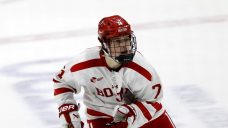As the calendar creeps towards American Thanksgiving next week, some NHL teams are starting to identify themselves as “no doubt” playoff contenders, while others are already starting to stare down the reality that they're destined for the draft lottery in the spring.
It makes for a long season when an organization recognizes it is not likely to be part of the Stanley Cup Playoffs. The one thing they have to look forward to is a high pick in the draft.
On Wednesday my energetic colleague, Sam Cosentino, published his November draft rankings. It’s an interesting group. Macklin Celebrini, in my opinion, is far and away the top-rated prospect. But I’m expecting a ton of movement in the rankings below him in the coming weeks and months.
Here’s a bit more of a deep dive into Sam’s top 10:
No. 1 Macklin Celebrini, C: Boston University (Hockey East)
Top ranked player for 2024 NHL Draft who is equal parts play driver and shooter.
Sets up on his weak side flank on the PP. Quick catch and release. One times pucks with accuracy and authority.
Competes in all three zones. Works hard on and off the puck. Can be trusted in a variety of roles.
Tied for the lead in NCAA scoring despite playing fewer games than others. Celebrini has eight goals and 10 assists in nine games. He's averaging over 20 minutes of ice time per game, the bulk of which comes at even strength and PP1.
An elite talent who plays quick and fast. Similar trajectory to Columbus' Adam Fantilli.
No. 2 Cole Eiserman, LW: USNTDP
Eiserman is a pure goal scorer with a “shoot first and ask questions later” approach. He is on pace to score 1.5 goals per game this season.
In the most recently completed Five Nations tournament in Finland he scored three goals and three assists in four games. Don’t be misled, however. His assists tend to come off rebounds when he has directed pucks on goal more than from him pulling up and looking to distribute.
I absolutely love his offensive upside, but his attention to detail defensively is a concern more than it should be. He’s cutting corners, hoping pucks get turned over so he can go on the offensive, rather than digging deep on and off the play in the defensive zone.
Eiserman is the kind of player who has to play in the top six forward group. There’s no question he has the skill to be a potential top line NHL scorer.
You can’t teach offence and defensive commitment is a choice.
No. 3 Ivan Demidov, RW: SKA St. Petersburg (KHL)
Demidov is dealing with a knee injury that he sustained in October. When healthy, I have a ton of time for this player. He brings a combination of size, speed, skill and will. Demidov can be dangerous off the rush. He also battles to extend plays from below the goal line, along the wall and he tracks back the full 200 feet. While offence is his upside, his overall compete also stands out. Coaches trust these kinds of players in a variety of roles.
Demidov projects as a top six forward who will possibly spill over the boards in all situations.
There’s always concerns about drafting Russian players and teams shy away from prospects who they don’t believe will be coming to North America anytime soon. Demidov has one year remaining on his contract with SKA St. Petersburg and he’s represented by Dan Milstein from Gold Star Hockey. Milstein has indicated Demidov is very much looking forward to coming to North America at the end of his current contract.
No. 4 Berkly Catton, C: Spokane Chiefs (WHL)
Catton is another offensive dynamo at the top of this draft class. He represented Team Canada at the Under-18 World Championships last spring as an under-age prospect, and also captained the summer team at the Hlinka-Gretzky Cup, leading the tournament in scoring with eight goals and two assists. So far this season he’s playing to his identity. He’s an assistant captain in Spokane where he’s scored 11 goals and 12 assists in 16 games.
Catton isn’t a big or powerful forward but he’s quick off the rush and sees the ice very well. Like most goal scorers, especially in recent years, he is very aggressive directing pucks on net. He will rip pucks on goal from all quadrants of the ice surface, including along the goal line. He’s not likely to penalty kill at the pro level, but he has average plus commitment on the defensive side of the ledger.
Catton projects as a top six NHL forward who will mostly be deployed at even strength and on the power play.
No. 5 Sam Dickinson, D: London Knights (OHL)
Dickinson could be the first defenceman off the board. The left shot defenceman brings a combination of size (6-foot-3, 194 pounds) and skill and he’s being used in all situations with London.
Dickinson has the ability to skate pucks out of trouble from deep in his zone, and the awareness to chip the play to open space when under duress. He’s a capable play maker on the power play as well. He also has a booming shot from distance that can beat goalies clean.
Defensively, he is best described as solid, but not spectacular. His size and length are definitely assets that assist with keeping opponents to the perimeter, but he could be more physically assertive at times.
Overall, there really aren’t any red flags with his game. Dickinson projects as a potential top pairing NHL defenceman who can be used in all situations.
No. 6 Artyom Levshunov, D: Michigan State (Big Ten)
Levshunov will give some of the names on this list a healthy dose of competition for a higher draft slot come June. Big, strong, right-shot defencemen are highly coveted throughout the NHL landscape and teams tend to overpay for them in trade. If an organization is in a position to draft and develop its own right-shot defenceman, it'll recognize the value in the pick.
Levshunov is off to a fantastic start this season. It’s a difficult ask for a defenceman who’s only 18 years young to take a regular shift at the NCAA level. Levshunov isn’t shy about directing pucks on net. He’s been credited with 31 shots on goal and has contributed four goals and eight assists with a plus-13 rating.
Levshunov is a solid skater with room to improve his small area escapes and agility (walking the offensive blue line for example). But he doesn’t cut corners in any zone, leans on opponents, and plays with a presence. He could end up finding a home as a top pairing NHL defenceman in time.
No. 7 Ryder Ritchie, RW: Prince Albert (WHL)
Ritchie is an interesting prospect. He’s not a big body, but he’s not small either. At 6-foot, 174 pounds I would expect him to at least add more weight as he matures and gets stronger. What I appreciate about his game is his effort tracking up and down the ice. When he suited up for Team Canada at the Hlinka-Gretzky Cup in the summer, he was involved. He doesn’t cheat the game and his reads are responsible. Rarely does he get caught deep in the offensive zone. He’s above the play when his group doesn’t have control of the puck.
Ritchie is the reigning WHL rookie of the year. He’s off to a strong start in Prince Albert again, scoring 12 goals and 13 assists in the first 23 games. He’s not shy about going to the net and he can also be a threat off the rush with the puck on his stick, or reading how the play is developing and making himself available arriving late on the scene.
No. 8 Anton Silayev, D: Torpedo (KHL)
Earlier on in this piece I mentioned that it’s hard to teach offence. It’s a gift to have that skill. The same can be said for size and Silayev is a mountain of a man. He stands 6-foot-7, weighs 207 pounds, and he’s only 17 years old! By the time he stops growing and fills out his frame, he could easily approach 225-230 pounds.
Silayev is playing in the KHL where he’s being used in all situations. Although his offence has dropped off recently, he continues to contribute in a variety of roles. His long reach and huge frame will assist him with his defending on the smaller ice surface in North America. What impresses me most is how smooth his skating stride is and how agile he is walking the offensive blue line to distribute pucks or direct them on goal from range.
Silayev has two assists in his most recent 10-game segment and he's getting between 13:30 and 15:40 of ice time, which is very impressive for a 17-year-old defenceman in the KHL.
No. 9 Michael Brandsegg-Nygard, RW: Mora (Allsvenskan)
Brandsegg-Nygard has a chance to become the first Norwegian-born first-round NHL pick. He’s a 6-foot-1 burner with an excellent shot and his catch and release is very quick. He shoots the puck in stride off the rush and has shown he can beat goalies from the top of the circles with an accurate snap shot.
He’s more than just offence, though. Brandsegg-Nygard is committed defensively and recognizes his responsibilities before going on offence. He could be a riser as the season rolls along. Projects as a potential top six NHL forward who plays fast and has the hockey sense to be used in a variety of roles.
No. 10 Cayden Lindstrom, C: Medicine Hat (WHL)
Lindstrom has a bit of throwback in his game. The first thing that stands out is his stature, listed at 6-foot-3-and-a-half, 205 pounds. He brings a combination of size, skill, and push back. His three zone compete is reliable. Lindstrom can be physically imposing to play against. He isn’t shy about finishing his check and taking the play to the net. His long reach assists with keeping his check to the perimeter in his zone, and extending plays along the wall in the offensive zone.
Lindstrom’s a solid skater who leans goal scorer more than distributor, but he does have some deception off the rush. He sees the ice very well and keeps opponents on their toes with his change of speed (and routes to the net) on his zone entries. He projects as a goal scoring, power forward type as a pro.






